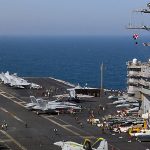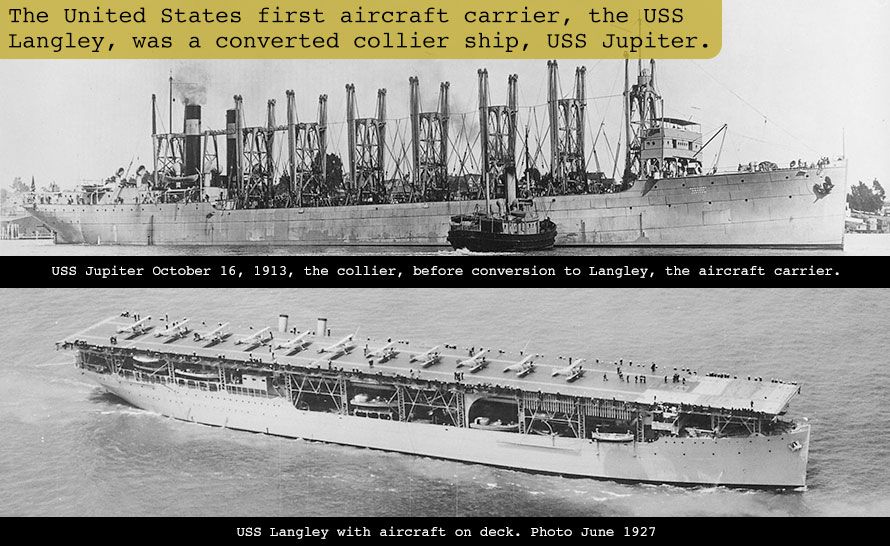When you think of aircraft stationed on a US aircraft carrier, the first plane that comes to mind is likely a fighter attack aircraft like the F/A-18E Super Hornet. However, the safety and welfare of the battle group depend just as heavily on two lesser-known carrier-based aircraft, the E-2 Hawkeye and C-2 Greyhound.
Two Lesser Known Carrier-Capable Aircraft
If you’ve watched Top Gun with Tom Cruise, in the very beginning you witnessed two F-14 Tomcat fighter jets scrambling toward an unidentified threat to the aircraft carrier. As they close the distance between themselves and the bogey, the American pilots cannot identify whether it’s an enemy fighter or more than one aircraft. It takes the two pilots, callsigns Maverick and Cougar, to be right on top of them and passing at high speed, to realize that it’s not just a MiG-28 (a fanciful aircraft type), but that there are actually two threats. Even the command and control center on the carrier had no idea the threat they were facing until the Tomcats visually identified them.
Also read: How Producers Got Maverick’s Realistic Flying Footage
Even during the 1980s when Top Gun was filmed, a U.S. aircraft carrier and its carrier battle group were not blind to the air space around them. They had powerful radar systems onboard that allowed them to see well over the horizon. Even the fighter jets flown by Maverick and Cougar had the ability to identify the approaching aircraft as friend or foe. But for the movie, the two F-14s were placed well within gun range before they knew it was two MiGs.
Watch “Top Gun (1986) First 10 Minutes”
U.S. Navy’s Eyes Of The Fleet
In reality, well before those F-14s would have been dispatched, the USS Enterprise would have had a much more effective tactical tool in the air, the E-2 Hawkeye. The E-2 is the U.S. Navy’s carrier-based airborne warning and control system (AWACS) aircraft – sometimes referred to as the “quarterback in the air.” Since its introduction into service in 1964, the twin-turboprop E-2 has served the U.S. Navy as its airborne early warning and command and control center. The Hawkeye has a 24-foot rotating radome spinning on top of its airframe housing the powerful APS-145 radar, or the APY-9 for the E-2D variants. This, along with its Identify Friend or Foe (IFF) and its passive detection systems, helps the E-2 to become the “eyes of the fleet” providing early warning, threat analysis, and control of counter actions against any air and/or surface targets. In the movie, had the E-2 been present like in a real scenario, the MiGs would have been identified from well over 150 miles away. The Hawkeye would have also directed those F-14 Tomcats to intercept the two enemy aircraft and provided in-depth situational awareness of the remainder of the battle area.
Today’s E-2C Hawkeye has a crew of five – two naval aviator pilots and three highly trained naval flight officers. With its advanced electronics and skilled crew, the E-2 can perform any mission that the U.S. Air Force’s much bigger E-3 Sentry AWACS can, but with 15 fewer people.
As a replacement for the E-1 Tracer, the U.S. Navy’s first purpose-built AWACS aircraft, the E-2 was introduced into service in January 1964. It is powered by two turboprops that produce 5,100 shp each. This provides the E-2 with a maximum speed of 400 mph and a cruising speed of 295 mph. Its ceiling is 34,700 feet and can operate for eight hours without refueling. The revolving radome rotates at six rpm and produces enough lift to offset its own weight. The Hawkeye can operate in all weather conditions and can monitor more than 600 targets simultaneously and more than 40 airborne targets.
The E-2 has been updated numerous times over its five decades of service. The U.S. Navy’s plan was to replace it with a completely different aircraft. Instead, they have opted to transition to the much more advanced E-2D Advanced Hawkeye, the newest variant of the E-2 platform.
Delivery or Very Important Personel and Cargo
The other very important carrier-based aircraft is the C-2 Greyhound. Its mission is not to provide protection to the carrier battle group, nor does it direct air traffic. But to the U.S. Navy’s men and women of the carrier battle group who depend on their mail to be delivered or important replacement parts to be transported, the C-2 is as important as any other aircraft on the flight deck.
Operating in the role of carrier onboard delivery (COD), the Greyhounds are busy little aircraft flying between the aircraft carrier and shore-based airfields to transport anything the ship may need like morale-lifting mail for the ship’s crew and high-priority cargo like a repaired turbojet engine for a grounded F/A-18 fighter jet. It is also used to transport crew and visiting dignitaries to and from the ship.
Also read: C-2 Greyhound Pilot Highly Focused During Carrier Landing – Split View
The C-2 is a high-wing carrier aircraft that was introduced into service in 1966 to replace the C-1 Trader. Like the E-2 Hawkeye, the C-2 Greyhound is powered by two Allison turboprop engines. It has a cruising speed of 289 MPH but a maximum speed of 395 mph. The ceiling for the C-2 is 30,000 feet and a range of 1,495 miles. The Greyhound has a two-man flight crew and two loadmasters. It can deliver up to 10,000 lbs over a distance of 1150 miles. The C-2 also has the capability to transport up to 28 passengers and can be configured to carry litter patients.
Read “Delivery Service on an Aircraft Carrier“
For the immediate future, the C-2 Greyhound will still be landing on the aircraft carrier trying to catch that third arresting cable. But eventually, the U.S. Navy plans to fully retire the C-2 and hand its roll as COD over to the CMV-22 Osprey, a long-range, medium-lift aircraft that can take off and land vertically like a helicopter but the wings transition to fly like a fixed-wing aircraft.
The United States Aircraft Carrier – It is known as 4.5 acres of sovereign American territory. While the eleven U.S. carriers, 200,000 tons of floating American diplomacy, are constantly circulating throughout the world, these two aircraft will continue to serve their very important missions while still not getting the recognition they truly deserve.







